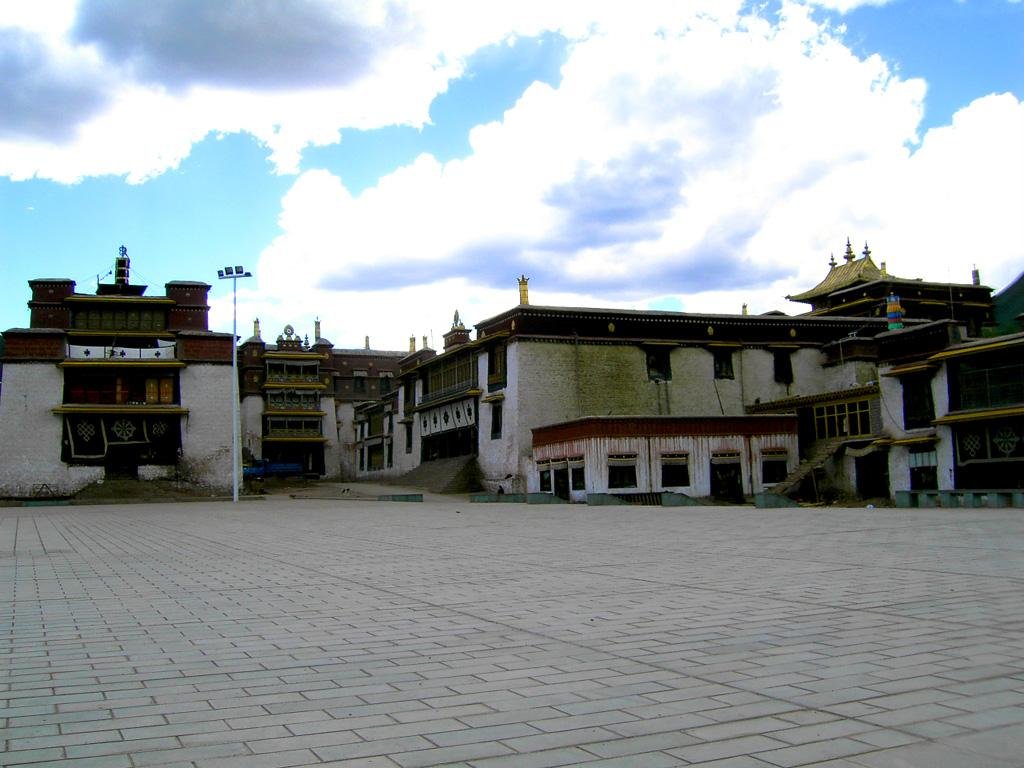Looking down from the top of the Tamala Pass, Chambaling Monastery appears tucked in the crisscrossing mountain ranges on a knoll-composed layers of red earth formed by ancient glaciers between the Tsarchu and Ngom Qu Rivers. This monastery was founded during the Ming period by a disciple of Tsongkapa after Tsongkapa's religious reform in Tibet. According to Gelug Sect rules, the Chamdo Monastery should harbor 2,500 monks.
When Tsongkapa made his journey into Tibet via Chamdo in 1373, he predicted that in the future a monastery would be erected and Buddhism would flourish in the area. Later, in 1437(year 2 of Zhengtong in Ming dynasty), Sherab Sangpo, one of Tsongkapa's disciples, founded the monastery on a rocky hill between the Ngom Qu and Tsarchu Rivers, and modeled it on a flying eagle about to land. The main relic is the statue of the Jampa (the Future Buddha) from which the name of the monastery, Chambaling is derived. The monastery is the largest of the Gelug Sect monasteries in Chamdo region and is divided into five colleges: the Lingtod, Lingme, Nupling, Kuchuk, and Chagra-khapa. By this time the monastery had one hundred and thirty subordinate monasteries in the Kham region, mostly concentrated in Chamdo, Drayak, Pagshod, Shopado, Sang-ngag Choling, and Powo.
The Monastery has always maintained close relationship with successive interior imperial counts. The giant living Buddha of the monastery has been granted titles since the reign of emperor Kangxi in the Qing dynasty. It still keeps the brass seal granted to Phagpalha Living Buddha during Emperor Kangxi’s Reign.
In Emperor Kangxi years, Chambaling Monastery made good effort to help Qing with its war against Zhunge’er Section. So the 6th Pagbalha was rewarded as “Nuomenhan” by Emperor Kangxi, and given a bronze seal, and he was also one of the six ho-thog-thues after Kangxi praised Panchen Erdini. Kangxi wrote “Ganden Chambaling Monastery” for the temple. At that time, the temple was under the most prosperous development, including 3500 Buddhas and 135 branch temples in Chamdo. Five Living Buddha had Zhacangs (the sutra halls):Lindui,Linmai, Nulin, Kuqiu and Jiarekaba,and the third Phagpalha used to be the master of the temple.


Chamdo is the gateway between Sichuan and Tibet, and so is an important trading center. The Monastery, too, engaged in trade. It distributed its profits equally among the monks in the form of daily necessities such as butter, “tsampa”(barley flour), brick tea etc. At the end of the year, the monastery equally distributed all the left profits. Chambaling Monastery was similar to other major Tibetan Buddhist Monasteries, with the well-reserved statues, frescos and Tangkas (Buddhist paintings). As one of the three leading temples in “old” Tibet, it took up a great amount of land and hired bondmen. But all “abbot”, “kanbu” and “Living Buddha” could not live luxury life according to the rules. The monastery stands high on the mountain, all Buddhas had to go down to the river and carry water to the monastery. There were twenty-two big bronze pots, each containing more than 100 barrels of water. Everyday, the residents living around carried drinking water to the monastery to support 2500 Buddha’s daily life.
Because the monastery is located at the highest part of Chamdo Town, you can have a bird view of the whole county, where the roaring Lantsang River converges Ngom Qu River and Tsarchu Rivers.
The monastery committee consists of 11 persons, including 1 supervisor and 3 assistant supervisors. They are in charge of monastery’s construction, security, teaching and finance, etc. All Buddhas begin to read the Buddhism books at 7a.m, then have seminar in afternoon, and review what they have done the whole day at 6 p.m. If anyone did not obey the rule, the monastery would quit him.
Scenic spot:
The monastery is famous for its well-reserved statues, frescos and Tangkas. The religious dance named Guqing is performed during every Tibetan New Year (one month after New Year’s Day). Dancers perform in splendid costumes. The dance enjoys high reputation in the Tibet Plateau and is worth looking.
Legends of the attraction:
It is said that when Master Tsongkapa went to Tibet from Qinghai by way of the juncture of the Lantsang River and Tsarchu River, he predicted that Chamdo would be a wonderful place to build temples and promote Buddhism. Later, Sherab Sangpo, a Lama of Gelug Sect from Kham, was appointed to promote Buddhism in Kham by Gyatsoje, a disciple of Tsongkapa. And finally he built a temple on the fourth terrace of Chamdo in 1444. Sherab Sangpo visited a Domdai officer(an officer in charge of 1,000 household) to collect money for the construction of the temple. The Domdai donated his own grassland as the site of the temple. Sandui, one of the 5 Zhacang, is the place where domdai built yak camps.









